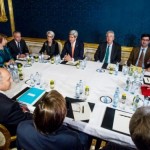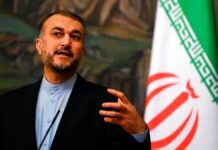 The UN atomic watchdog said today that Iran has complied with last July’s nuclear deal, and American and European officials in Vienna immediately announced that deal was officially implemented, and that nuclear sanctions on the Islamic republic had been removed.
The UN atomic watchdog said today that Iran has complied with last July’s nuclear deal, and American and European officials in Vienna immediately announced that deal was officially implemented, and that nuclear sanctions on the Islamic republic had been removed.
Under authority delegated to him by US President Barack Obama, Secretary of State John Kerry signed documents confirming the US government had received the report and waivers to implement the lifting of US Congressional sanctions.
Iran reentered the global economy as years of crippling international sanctions were lifted in exchange for the verified disabling of much of its nuclear infrastructure.
For Iran, implementation of the landmark deal it finalized with six world powers last summer means immediate access to more than $50 billion in long-frozen assets, and freedom to sell its oil and purchase goods in the international marketplace. Tehran has hailed the deal as vindication of its power and influence in the world.
“Today marks the start of a safer world,” said Secretary of State John F. Kerry. “We understand this marker alone will not wipe away all the concerns the world has rightly expressed about Iran’s policies in the region. But we also know there isn’t a challenge in the entire region that wouldn’t become much more complicated, much worse, if Iran had a nuclear weapon.”
The removal of sanctions comes as President Obama begins his last year in office, and almost seven years to the day since he called on Iran to “unclench your fist” and take steps toward rapprochement with the United States and the world. As a result of the agreement, he said in his last State of the Union speech this week, a “nuclear-armed Iran” has been prevented, and “the world has avoided another war.”
The triggering event for implementation was certification by the International Atomic Energy Agency Saturday that Iran had successfully completed all the nuclear steps it agreed to in July: sending the bulk of its enriched uranium outside the country, mothballing most of its centrifuges, and disabling its Arak nuclear reactor, capable of yielding plutonium. The IAEA is also charged with monitoring and verifying Iran’s continued compliance. Iran has long insisted that it had no intention of building a nuclear weapon and its program was solely for peaceful energy purposes.
Agency inspectors on the ground “verified that Iran has carried out all measures required….to enable Implementation Day to occur,” IAEA Director General Yukiya Amano said in a statement issued just before midnight, Vienna time. Amano will travel to Iran on Sunday.
IAEA certification of compliance opened the door to announcements and speeches by high-level officials from the negotiating parties. A new U.N. resolution codifying the deal immediately went into effect. The IAEA begins strict monitoring provisions on the ground in Iran. With the White House lifting executive orders regarding nuclear sanctions, Kerry signing waivers of other restrictions and the European Union and U.S. Treasury issuing implementation guidance, the wheels of international business and finance will begin turning.
To the consternation of critics of the agreement in the United States — including Republican presidential hopefuls who have called it a dangerous sellout by Obama and vowed to dismantle it — the deal is now done.
In the long term, the agreement is a major milestone in the Iranian revolution, with the potential for far-reaching economic, political and cultural ramifications. The end of Iran’s near-total economic isolation could drive more modernization and open the country to moderating outside influences. More money spent at home to upgrade failing infrastructure and jump-start the economy would allow pragmatist President Hassan Rouhani to showcase the sanctions relief he pledged in his 2013 campaign.
U.S. and international opponents, including Israel, Saudi Arabia and other U.S. allies see the agreement as a dangerous gift to an aggressive and duplicitous regime, and have warned that Tehran will use the money to increase spending on terrorist groups that serve as its proxies in a fight for regional dominance.
Although Iran has more than $100 billion in available frozen assets — most of it in banks in China, Japan and South Korea — slightly less than half will more or less automatically go to preexisting debts. How the rest is spent will reveal the direction of internal power battles between Iranian hard-liners and pragmatists.
That kind of money is too much to be transferred in one fell swoop. Richard Nephew, a former sanctions chief of the U.S. negotiating team, said the Iranians will likely transfer it out in chunks, and may even leave it in place while they decide how to spend it.
“They’re going to find there are more demands” for the money, about $56 billion, “than they have plans to use it,” he said. “The question is to what degree will they have fights at home about what to do with it.”
While international sanctions, and those applying to U.S. companies abroad, are largely lifted, U.S. bilateral economic and other sanctions remain in place.
The U.S. Treasury Department keeps close track of resources flowing to Lebanon-based Hezbollah, Iran’s most powerful proxy force in the region that is playing a major role in support of besieged Syrian President Bashar al-Assad. “I suspect they are going to get an increase in material support” that will “become apparent in the next couple of months,” said Dennis Ross, a former senior Obama adviser on the region.
Another indicator to watch, Ross said, is the selection of candidates for upcoming parliamentary elections in Iran in late February. To appear on the ballot, candidates must be vetted and approved by Iran’s Guardian Council, controlled by Supreme Leader Ali Khamenei.
“If it turns out that many of those who are identified with Rouhani and are more pragmatic are permitted to be candidates, that will tell us something,” Ross said. “If that is not the case, it will also tell us something.”
Despite official rejoicing by the negotiating partners, implementation comes at a particularly inauspicious time for Iran and the United States.
Oil is at its lowest price in more than a decade, in part because of expectations Iranian crude will flood the market, and Iran’s currency has declined precipitously. Tehran will be getting far less income than it anticipated when the negotiations took hold in late 2013, making it difficult for the government to deliver the jobs and economic boom Iranians have been told will ensue. Many think it will take years to repair the country’s decrepit energy infrastructure in order for oil to flow at its pre-sanctions rate.
In Washington, the deal is even more contentious politically now than it was when it was signed with Iran six months ago in Vienna by the governments of the United States, Britain, France, Russia, China, Germany and the European Union. Videos of kneeling U.S. sailors detained this week by the Iranian Revolutionary Guard navy have outraged many in Congress who were already incensed by the agreement. The sailors, whose boat strayed into Iranian waters, were released Wednesday after being held overnight.
U.S. non-nuclear sanctions related to terrorism and other Iranian activities remain in place. Lawmakers have called for additional American restrictions on Iran for test-firing ballistic missiles in October and November in apparent violation of then-existing U.N. sanctions. And since the deal was finalized, Iran has taken a fourth U.S. citizen into custody, fueling anger by critics that Obama has moved ahead while ignoring their fate.
(c) The Washington Post
{Matzav.com Newscenter}












SHAME ON ALL THE “ONCE UPON A TIME PEACEFUL COUNTRIES” like the United States, the European Union.
looks like 1938 = 2016 chas v’Sholom – HASHEM YERACHEIM
Obama is a gilgul